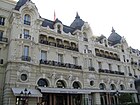Second Empire architecture in Europe
Development
The Second Empire style quickly spread throughout Europe and evolved as a loose form of Baroque Revival architecture, where its suitability for super-scaling allowed it to be widely used in the design of municipal and corporate buildings
The style is particularly prominent in Paris and Vienna, both of which were heavily redeveloped in the late 19th century. Rome also saw a huge expansion after the
Second Empire became popular in Britain at the end of the nineteenth century, where it emerged as a fusion of the architecture of the classical Renaissance exemplified by Christopher Wren and the solid mass Baroque of John Vanbrugh, decorated with some of the more ornate Baroque motifs previously found only on mainland Europe.[3] It often featured a low dome, a once complex architectural feat rendered less difficult through the use of iron and reinforced concrete.
In London, the style is exemplified by
-
Hôtel de Paris Monte-Carlo, Monaco, was completed in 1868
-
Brussels Stock Exchange was designed by Léon Suys and built between 1868–73
-
Karl Freiherr von Hasenauer and completed in 1888, is a prime example of the Second Empire style[6]
-
Methodist Central Hall, Westminster, completed in 1911
See also
References
- ^ Copplestone, p. 310.
- ^ Britannica.com retrieved 17 October 2016
- ISBN 9781905400492.
- ISBN 085244141X. Retrieved October 19, 2012.
- ISBN 978-1405384773. Retrieved October 20, 2012.
- ^ Copplestone, p. 311.
- Copplestone, Trewin (1963). World Architecture. Hamlyn.



![Burgtheater, Vienna, designed by Gottfried Semper and Karl Freiherr von Hasenauer and completed in 1888, is a prime example of the Second Empire style[6]](http://upload.wikimedia.org/wikipedia/commons/thumb/c/c5/Burgtheater_Weitwinkel.jpg/140px-Burgtheater_Weitwinkel.jpg)
